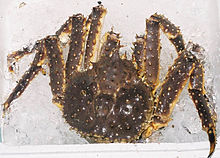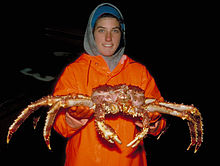
The Bering Sea is a marginal sea of the Northern Pacific Ocean. It forms, along with the Bering Strait, the divide between the two largest landmasses on Earth: Eurasia and the Americas. It comprises a deep water basin, which then rises through a narrow slope into the shallower water above the continental shelves. The Bering Sea is named after Vitus Bering, a Danish navigator in Russian service, who, in 1728, was the first European to systematically explore it, sailing from the Pacific Ocean northward to the Arctic Ocean.
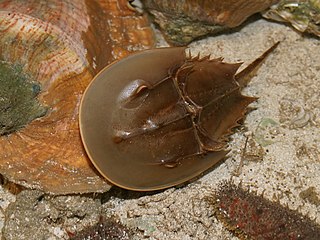
The Atlantic horseshoe crab, also known as the American horseshoe crab, is a species of horseshoe crab, a kind of marine and brackish chelicerate arthropod. It is found in the Gulf of Mexico and along the Atlantic coast of North America. The main area of annual migration is Delaware Bay along the South Jersey Delaware Bayshore.
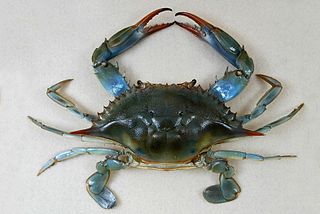
Callinectes sapidus, the blue crab, Atlantic blue crab, or, reigonally, the Maryland blue crab, is a species of crab native to the waters of the western Atlantic Ocean and the Gulf of Mexico, and introduced internationally.

The Japanese spider crab is a species of marine crab and is the biggest one that lives in the waters around Japan. It has the largest known leg-span of any arthropod around 3.7 meters. The Japanese name for this species is taka-ashi-gani,, literally translating to “tall legs crab”. It goes through three main larval stages along with a prezoeal stage to grow to its great size.

The Dungeness crab makes up one of the most important seafood industries along the west coast of North America. Its typical range extends from Alaska's Aleutian Islands to Point Conception, near Santa Barbara, California. Dungeness typically grow 6-7 inches at their widest point and inhabit eelgrass beds and sandy bottoms. Its common name comes from the Dungeness Spit in the Strait of Juan de Fuca, Washington state, United States, which shelters a shallow bay inhabited by the crabs.

King crabs are a taxon of decapod crustaceans that are chiefly found in cold seas. Because of their large size and the taste of their meat, many species are widely caught and sold as food with the most common being the red king crab.

Portunus pelagicus, also known as the blue crab, blue swimmer crab, blue manna crab and flower crab is a species of large crab found in the Indo-Pacific, including off the coasts Indonesia, Malaysia, Cambodia, Thailand, the Philippines, and Vietnam; and in the intertidal estuaries around most of Australia and east to New Caledonia.
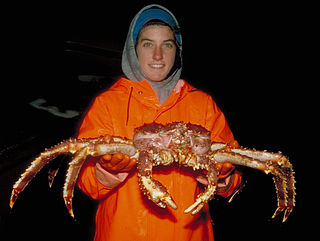
Alaskan king crab fishing is carried out during the fall in the waters off the coast of Alaska and the Aleutian Islands. The commercial catch is shipped worldwide. Large numbers of king crab are also caught in Russian and international waters.

The common octopus is a mollusk belonging to the class Cephalopoda. Octopus vulgaris is one of the most studied of all octopus species, and also one of the most intelligent. It ranges from the eastern Atlantic, extends from the Mediterranean Sea and the southern coast of England, to the southern coast of South Africa. It also occurs off the Azores, Canary Islands, and Cape Verde Islands. The species is also common in the Western Atlantic.

The Puget Sound king crab, is a species of king crab which inhabits the oceans of the Pacific coast of North America from Alaska to central California. Adults are orange, red and purple in color, while juveniles are either mostly orange or have small blotches of red and purple. They can be recognized by their blunt bumps on their carapace. Puget Sound king crabs are larger than the similar brown box crab, with an average size of 6–10 inches (15–25 cm).
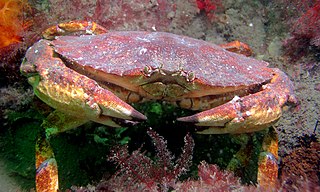
The red rock crab, one of several species known as red rock crabs, is a crab of the genus Cancer found on the western coast of North America. This species is commonly nicknamed the Pearl of the Pacific Northwest.
This page is a list of fishing topics.

The purple shore crab is a common crab of the family Varunidae that is indigenous to the west coast of United States, Canada, and Mexico. H. nudus was first described in 1847 by Adam White, and in 1851, James Dwight Dana formally classified the species. H. nudus is a small, amphibious crab that is similar physically and behaviorally to Pachygrapsus crassipes and Hemigrapsus oregonensis. The purple shore crab is generally a dark purple color with olive green, red, and white spots. Mating season for H. nudus begins in mid-winter and larval crabs undergo 5 zoeal stages and a juvenile stage. Adult crabs mainly feed on algae but will occasionally scavenge other animals. H. nudus prefers inter-tidal and sub-tidal zones, and it can oftentimes be found sheltering under rocks or other debris. H. nudus demonstrates complex compensatory mechanisms to counteract fluctuating salinity and water oxygen concentrations, permitting it to live in a variety of different environments.

Paralithodes platypus, the blue king crab, is a species of king crab from cold waters in the North Pacific Ocean and adjacent seas. Although blue king crabs are among the largest crabs in the world and reputedly may exceed 18 pounds (8.2 kg) in weight, they are generally smaller than red king crabs.
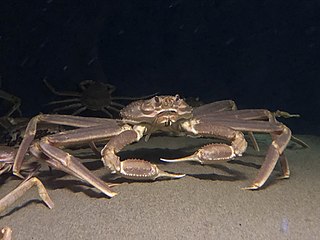
Chionoecetes opilio, a species of snow crab, also known as opilio crab or opies, is a predominantly epifaunal crustacean native to shelf depths in the northwest Atlantic Ocean and north Pacific Ocean. It is a well-known commercial species of Chionoecetes, often caught with traps or by trawling. Seven species are in the genus Chionoecetes, all of which bear the name "snow crab". C. opilio is related to C. bairdi, commonly known as the tanner crab, and other crab species found in the cold, northern oceans.

Neolithodes is a genus of king crabs, in the family Lithodidae. They are found in all major oceans, both in high and low latitudes. Although there are records from water as shallow as 124 m (407 ft) in cold regions, most records are much deeper, typically 700–2,000 m (2,300–6,600 ft), with the deepest confirmed at 5,238 m (17,185 ft). They are fairly large to large crabs that typically are reddish in color and spiny, although the size of these spines varies depending on species.

Loxorhynchus grandis, commonly known as the sheep crab or spider crab, is a species of crab in the family Epialtidae. It is the largest crab found on the California coast. The species was first described to science by William Stimpson in 1857. The type specimen was collected on the coast of California, near San Francisco. Fossils from the late Miocene epoch indicate that this species is at least 11.63 to 5.333 million years old.
Illegal, unreported and unregulated fishing (IUU) in the Arctic is an under researched scientific field. The most recent academic articles about IUU in the Arctic mainly concerns the mid-2000s.
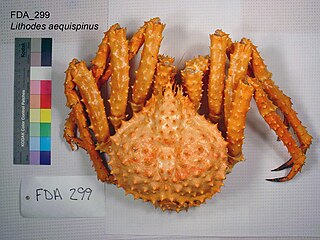
Lithodes aequispinus, the golden king crab, also known as the brown king crab, is a king crab species native to the North Pacific. Golden king crabs are primarily found in the Aleutian Islands and waters nearer to Alaska and British Columbia; their range also extends to the Russian far east and Japan, albeit with a less dense population. Golden king crabs are the smallest of the three commercially viable Alaskan king crab species with an average weight between 5 and 8 lbs ; the other two species being the blue and red king crabs. Golden king crabs were historically caught incidentally in red king crab fisheries, but the first commercial landing took place in 1975; in 1981, the targeted pot-fishing method, a hybrid fishing method specifically for golden king crab, was developed.
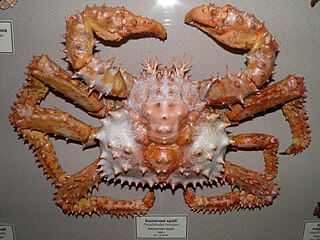
Paralithodes brevipes is a species of king crab. It has a limited distribution in cold, shallow waters as far south as the coast of Hokkaido, where male-only fishing has damaged the reproductive success of the species, up to as far north as the southwest Bering Sea.
